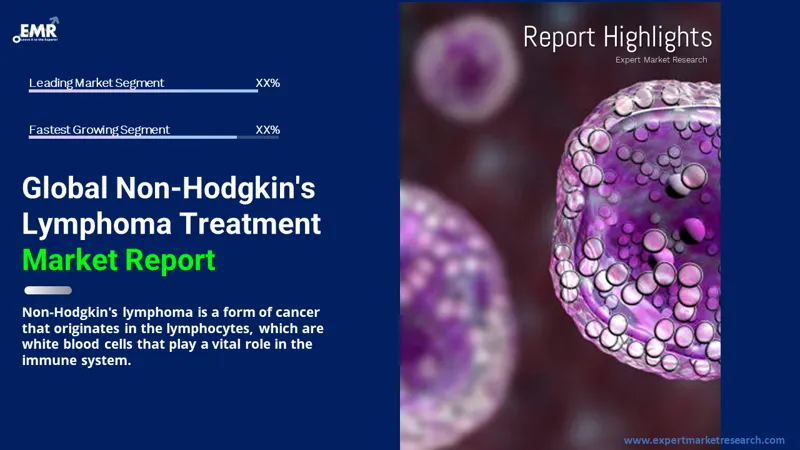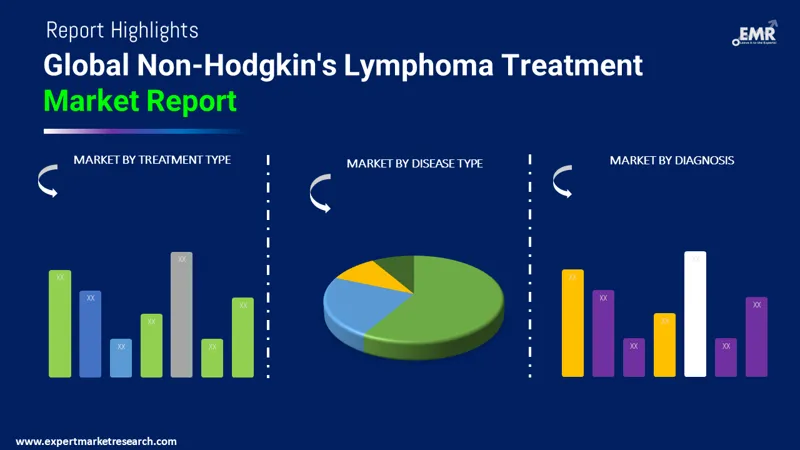
Consumer Insights
Uncover trends and behaviors shaping consumer choices today
Procurement Insights
Optimize your sourcing strategy with key market data
Industry Stats
Stay ahead with the latest trends and market analysis.
The global non-Hodgkin’s lymphoma treatment market attained a value of USD 14.41 Billion in 2025. The market is expected to grow further at a CAGR of 7.20% during the forecast period of 2026-2035 to attain a value of USD 28.88 Billion by 2035, driven by the rising technological advancement and the increased availability of treatments.
Base Year
Historical Period
Forecast Period
Compound Annual Growth Rate
7.2%
Value in USD Billion
2026-2035
*this image is indicative*
Non-Hodgkin's lymphoma is the type of cancer that develops in the white blood cells of the immune system, which are also known as lymphocytes. When these white blood cells start growing abnormally, they start forming tumours throughout the body.
Major sites of these lymph tissue include lymph nodes, spleen, bone marrow, thymus, digestive tract, adenoids, and tonsils, among others. NHL is inclusive of different types of blood cancers. The subtypes can either progress slowly (indolent subtype) or spread rapidly (aggressive subtype). The non-Hodgkin’s lymphoma can be of two types, that is B cells and T cells. B cells are the cells which are responsible for producing antibodies which help in fighting off infections. On the other hand, T cells have different functions, including the role of providing support to the B cells in antibodies production.
While the exact cause of non-Hodgkin’s lymphoma continues to be ambiguous, some of the potential factors responsible for the condition are genetic factors, lifestyle, infections, weak immune system, occupation, and the medical history of the patient as well as their family, among other factors.
The symptoms of the condition are sometimes so common that the patient tends to mistake them for general flu or virus. The signs and symptoms significantly rely on factors like the location of the tumour, its size, and its growth speed. The most common signs and symptoms of the disease include fever, nausea, fatigue, significant weight loss, skin problems like rashes or itchy skin, pain in bones, abdomen, or chest without any reason, severe sweat at night, and swollen lymph nodes, among others.
These symptoms can either happen separately or all at once. For instance, when symptoms like night sweats, severe weight loss, and fever happen together, then these symptoms are clubbed as B symptoms.

Read more about this report - REQUEST FREE SAMPLE COPY IN PDF
The market can be categorized into segments like treatment type, disease type, diagnosis, and major regions.
Market Breakup by Treatment Type
Market Breakup by Disease Type
Market Breakup by Diagnosis
Non-Hodgkin's Lymphoma Treatment Market Breakup by Region

Read more about this report - REQUEST FREE SAMPLE COPY IN PDF
The growth of the market is likely to grow significantly over the forecast period owing to the rising number of cases amongst children. The rising demand for the treatment market can also be attributed to the rising technological advancements, rising number of approved drugs and treatments, as well as the development of new and advanced drugs.
Globally, North America is anticipated to account for a significant share over the coming years since the region is technologically advances and the awareness about different types of cancer in the region is high. The awareness about the importance of conducting regular health check-ups has also propelled the growth of the market. Other than North America, Europe and Asia Pacific are also likely to witness robust growth in the coming years with the rapidly rising number of cases across these regions.
The prevalence of the disease is constantly across the globe. The total number of cases in the year 2023 reached around 570,000. Older people are more vulnerable to this condition, especially people belonging to the age group of 65-75; however, it can happen to anyone. Men are more likely to suffer from the disease than women. People who consume immunosuppressant drugs immediately after any organ transplant are also at a higher risk of having this condition.
NHL is a disease which attacks people who have a weaker immune system. Variety of factors could lead to a weaker immune system. These factors include inherited immunity ailments like Wiskott-Aldrich syndrome and hypogammaglobulinemia, autoimmune conditions like HIV/ AIDS, psoriasis, arthritis, or Sjögren syndrome, Helicobacter pylori infection, and Epstein-Barr virus infection or Human T-lymphotropic virus type I.
Various treatment methods are used for NHL including radiation therapy, chemotherapy, immunotherapy, targeted therapy, Plasmapheresis, antibiotic therapy, and surgery, among others. The three major treatment methods covered in this report include the following:
Immunotherapy- This treatment uses the patient’s immunity system to fight the cancer cells. Medications are used to boost the immunity system of the patient to kill the cancer cells, which also helps in preventing further growth of cancer cells. Immunomodulators like Lenalidomide are used to treat adult non-Hodgkin lymphoma. Immunotherapy also includes the use of CAR T-cell therapy.
Targeted Therapy- This therapy uses certain drugs to attack the cancer cells. Some of the prominent therapies under this treatment type include proteasome inhibitor therapy, monoclonal antibody therapy, and kinase inhibitor therapy.
Chemotherapy- This treatment includes the use of drug which is given either orally or through drip or injections to the patient. In some cases, the patient might require a combination of both. To avoid the risk of cancer reaching the brain, these injections might be injected directly into the cerebrospinal fluid, that is around the spine. Chemotherapy is given in an interval of months, depending on the patient’s response to the drugs.
No matter which method of treatment is opted for the patient, these drugs are extremely strong and lead to sever side effects. Some of these toxic side effects also include loss of fertility, paralysis, different types of cancer, and baldness, among others.
The major companies working on the drugs and treatment of the condition, and investing in the clinical trials include the following:




*While we strive to always give you current and accurate information, the numbers depicted on the website are indicative and may differ from the actual numbers in the main report. At Expert Market Research, we aim to bring you the latest insights and trends in the market. Using our analyses and forecasts, stakeholders can understand the market dynamics, navigate challenges, and capitalize on opportunities to make data-driven strategic decisions.*
Get in touch with us for a customized solution tailored to your unique requirements and save upto 35%!
In 2025, the market attained a value of nearly USD 14.41 Billion.
The market is projected to grow at a CAGR of 7.20% during the forecast period of 2026-2035.
The market is estimated to witness robust growth during the forecast period of 2026-2035 to reach a value of USD 28.88 Billion by 2035.
The growth of the market is driven by the rising prevalence of the disease, availability of treatment, and the technological advancement in the healthcare sector.
The rising awareness about the importance of early detection acts as a key trend for the market.
The major regions in the market are North America, Latin America, the Middle East and Africa, Europe, and the Asia Pacific.
The treatment types include immunotherapy, targeted therapy, and chemotherapy, among others.
The disease can be divided into two types, B-cell and T-cell lymphoma.
The diagnosis methods include Biopsy, Cell and Tissue Study, Blood Tests, and imaging types, among others.
The major players in the market are Eli Lilly and Company, Corvus Pharmaceuticals, Rafael Pharmaceuticals, AbbVie, ADC Therapeutics, Genetech, Tessa Therapeutics, and Bristol Myers Squibb.
Explore our key highlights of the report and gain a concise overview of key findings, trends, and actionable insights that will empower your strategic decisions.
| REPORT FEATURES | DETAILS |
| Base Year | 2025 |
| Historical Period | 2019-2025 |
| Forecast Period | 2026-2035 |
| Scope of the Report |
Historical and Forecast Trends, Industry Drivers and Constraints, Historical and Forecast Market Analysis by Segment:
|
| Breakup by Treatment Type |
|
| Breakup by Disease Type |
|
| Breakup by Diagnosis |
|
| Breakup by Region |
|
| Market Dynamics |
|
| Supplier Landscape |
|
| Companies Covered |
|
Single User License
One User
USD 5,499
USD 4,949
tax inclusive*
Datasheet
One User
USD 3,299
USD 2,969
tax inclusive*
Five User License
Five User
USD 6,999
USD 5,949
tax inclusive*
Corporate License
Unlimited Users
USD 8,199
USD 6,969
tax inclusive*
*Please note that the prices mentioned below are starting prices for each bundle type. Kindly contact our team for further details.*
Flash Bundle
Small Business Bundle
Growth Bundle
Enterprise Bundle
*Please note that the prices mentioned below are starting prices for each bundle type. Kindly contact our team for further details.*
Flash Bundle
Number of Reports: 3
20%
tax inclusive*
Small Business Bundle
Number of Reports: 5
25%
tax inclusive*
Growth Bundle
Number of Reports: 8
30%
tax inclusive*
Enterprise Bundle
Number of Reports: 10
35%
tax inclusive*
How To Order

Select License Type
Choose the right license for your needs and access rights.

Click on ‘Buy Now’
Add the report to your cart with one click and proceed to register.

Select Mode of Payment
Choose a payment option for a secure checkout. You will be redirected accordingly.
Gain insights to stay ahead and seize opportunities.

Get insights & trends for a competitive edge.

Track prices with detailed trend reports.

Analyse trade data for supply chain insights.

Leverage cost reports for smart savings

Enhance supply chain with partnerships.

Connect For More Information
Our expert team of analysts will offer full support and resolve any queries regarding the report, before and after the purchase.
Our expert team of analysts will offer full support and resolve any queries regarding the report, before and after the purchase.
We employ meticulous research methods, blending advanced analytics and expert insights to deliver accurate, actionable industry intelligence, staying ahead of competitors.
Our skilled analysts offer unparalleled competitive advantage with detailed insights on current and emerging markets, ensuring your strategic edge.
We offer an in-depth yet simplified presentation of industry insights and analysis to meet your specific requirements effectively.
Share